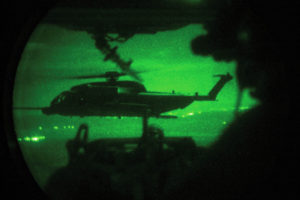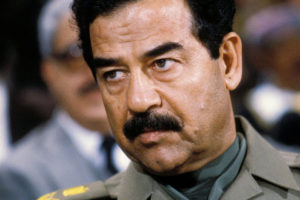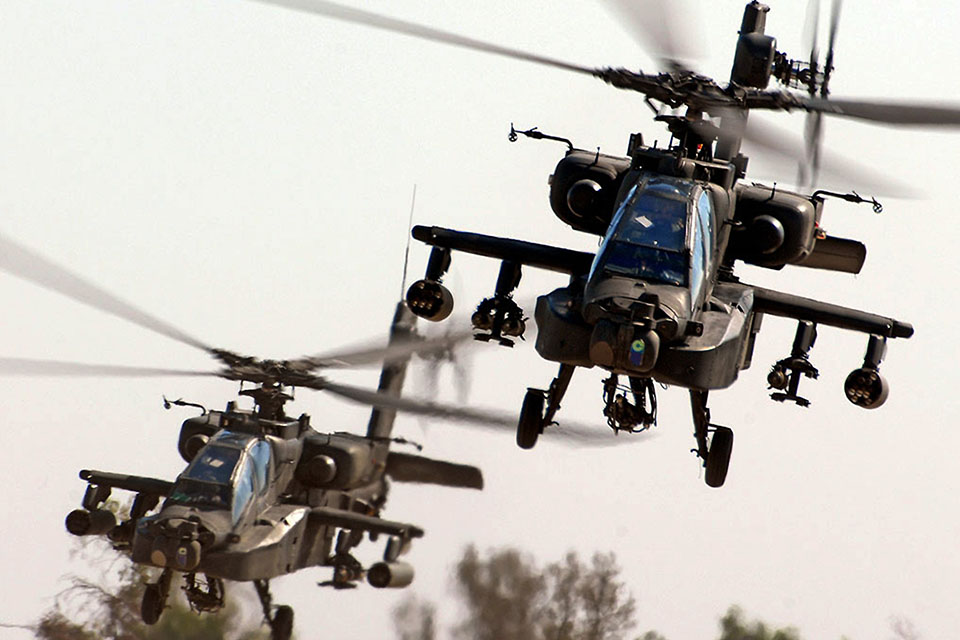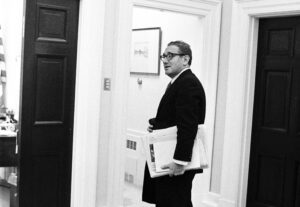Fifty-six minutes after midnight on Jan. 17, 1991, four U.S. Air Force MH-53J Pave Low III special operations helicopters and nine Army AH-64A Apache attack helicopters began lifting off from Forward Operating Base Al Jouf in Saudi Arabia bound for two targets deep within Iraqi airspace. Countless hours of exhaustive training behind them, the success of the aviators’ incipient mission hinged on every aspect of a highly choreographed operation falling into place at exactly the right moment—including the faultless operation of onboard global positioning systems that relied on satellites controlled from the other side of the world.
 Their mission was the opening salvo of a coordinated aerial assault against the regime of Saddam Hussein. The Iraqi dictator had sent his armed forces into neighboring Kuwait on Aug. 2, 1990, claiming the wealthy, oil-producing constitutional monarchy as Iraq’s 19th province. Saddam had then further stoked the fires of international outrage by apparently readying his military for an invasion of Saudi Arabia—if successful, the move would have given Iraq’s strongman control of nearly half of the world’s known oil reserves, destabilizing the Persian Gulf region and disrupting the world economy.
Their mission was the opening salvo of a coordinated aerial assault against the regime of Saddam Hussein. The Iraqi dictator had sent his armed forces into neighboring Kuwait on Aug. 2, 1990, claiming the wealthy, oil-producing constitutional monarchy as Iraq’s 19th province. Saddam had then further stoked the fires of international outrage by apparently readying his military for an invasion of Saudi Arabia—if successful, the move would have given Iraq’s strongman control of nearly half of the world’s known oil reserves, destabilizing the Persian Gulf region and disrupting the world economy.
The international response to Iraq’s aggression was initially confined to diplomatic channels, the United Nations and Arab League each condemning the invasion and calling for the immediate withdrawal of Iraqi armed forces from Kuwait. Next came economic sanctions and arms embargoes. The United States, while supporting such measures, took a harder line. Five days after Iraq’s invasion—with the blessing of Saudi Arabia’s King Fahd—President George H.W. Bush launched Operation Desert Shield, ordering American air and ground forces into Saudi Arabia to shore up the kingdom’s defenses, and dispatching two U.S. Navy battle groups to the Persian Gulf in a show of force.
On November 29, given Saddam’s stubborn refusal to pull his forces out of Kuwait and his increasingly bellicose threats toward Saudi Arabia and other states in the region, the U.N. Security Council adopted Resolution 678, setting a Jan. 15, 1991, deadline for Iraq’s withdrawal from Kuwait and authorizing the international community to use “all necessary means” to eject Saddam’s troops from the tiny nation if those forces did not leave voluntarily.
It was, in effect, an authorization for war against Iraq.
Even as diplomatic efforts were under way, the United States spearheaded efforts to assemble an international military coalition for possible use against Saddam, with 34 nations—representing the largest coalition since World War II—ultimately providing troops, military hardware and/or financial and logistical support. U.S. Army General H. Norman Schwarzkopf Jr., the commander of coalition forces, ordered his planners to formulate an offensive to both reduce the risk of an Iraqi assault against Saudi Arabia and eject Saddam’s forces from Kuwait. To do so, planners had to overcome a host of obstacles, including political and religious rivalries among member states, logistical and operational complications inherent in the conduct of a multinational campaign and the myriad challenges presented by mechanized desert warfare.
Planners presented Schwarzkopf with an initial draft of the coalition plan on August 10, just eight days after the Iraqi invasion of Kuwait. Code-named Operation Instant Thunder, it emphasized a massive air strike on the Iraqi capital, Baghdad, and the many fortified command bunkers of Saddam’s military forces. Although the plan included an innovative and generally well-received operation to knock out Iraq’s air defenses, it fell short in other areas. Among the main points of contention were the plan’s assumption such strikes would induce an Iraqi withdrawal, and it failed to consider how Saddam’s elite Republican Guard—omitted from the target list—would respond to a coalition attack. These and other shortcomings led to the plan being rejected in short order. On August 21 U.S. Air Force Lt. Gen. Charles Horner, the Riyadh-based commander of coalition air operations, brought in Air Force Brig. Gen. Buster C. Glosson to revise the plan, giving him less than a week to prepare a briefing.
Glosson and his team worked around the clock from an office in the basement of the Royal Saudi Air Force building in Riyadh. In the days that followed Glosson’s planning group—dubbed the “Black Hole,” as those who joined it never seemed to re-emerge—hammered out the basics of a four-phase strategic air campaign. The critical first phase called for a ground attack by special operations forces intended to destroy the radar sites in western Iraq.
Briefed on the plan on September 3, Schwarzkopf was initially impressed by Glosson’s plan, but three weeks later planning came to an abrupt halt when a requisition for GPS-equipped ground vehicles arrived on Schwarzkopf’s desk, igniting the general’s fury. Glosson was immediately summoned before an irate Schwarzkopf, who lambasted the notion of using special operations ground forces. A highly decorated foot soldier, Schwarzkopf had proven himself a resourceful and reliable combat leader in Vietnam. But it was also in Southeast Asia where a string of bad experiences with special operations forces had soured the general’s opinion of such “hotshot” units, and Schwarzkopf made it abundantly clear he intended to keep their numbers as low as possible. He then nixed Phase I of Glosson’s plan in its entirety.
The Air Force officer vanished back into the Black Hole, knowing the destruction of the Iraqi radar sites remained the essential prelude to any large-scale aerial assault on Saddam and his military forces. With the possibility of using ground troops off the table, the team considered the use of helicopters. In a matter of hours Glosson and his subordinates prepared an updated attack plan built around Army AH-64A Apaches, war machines equipped with almost everything necessary for a successful first strike, including firepower and the ability to photographically verify damage. But the Apaches lacked the navigation equipment necessary to guide them to and from their targets, so Glosson and his planners added Air Force MH-53J Pave Low IIIs to the mix. Equipped with new GPS receivers, the Pave Lows were capable of providing the pinpoint navigational accuracy the Apaches would require.
Glosson presented the revised plan to Schwarzkopf, detailing his reasoning for using the Pave Lows. Such a joint-forces operation, Glosson explained, would be more than capable of knocking a gaping hole in Iraq’s air defense system, thereby paving the way for an aerial assault. The Air Force general also stressed that without the pairing of the Army and Air Force helicopters, the mission would be a no-go. Despite his distaste for anything labeled “special operations,” Schwarzkopf saw Glosson’s logic and approved the plan.
 Saddam’s army was the fourth largest in the world at the time, with nearly 1 million men under arms. The regime had long relied on the Soviet Union for materiel support, and its air defenses were built around various truck-mounted, Soviet-made surveillance and target-acquisition radars referred to in the West as “Flat Face,” “Squat Eye” and “Spoon Rest.” These radars controlled associated anti-aircraft gun and missile systems, forming a “picket fence” around Iraq. Glosson’s plan called for three sites in western Iraq to be knocked out simultaneously in order to open a safe corridor for incoming coalition aircraft bound for Baghdad and other targets.
Saddam’s army was the fourth largest in the world at the time, with nearly 1 million men under arms. The regime had long relied on the Soviet Union for materiel support, and its air defenses were built around various truck-mounted, Soviet-made surveillance and target-acquisition radars referred to in the West as “Flat Face,” “Squat Eye” and “Spoon Rest.” These radars controlled associated anti-aircraft gun and missile systems, forming a “picket fence” around Iraq. Glosson’s plan called for three sites in western Iraq to be knocked out simultaneously in order to open a safe corridor for incoming coalition aircraft bound for Baghdad and other targets.
The mission was rife with complexity. The aircrews would be tasked with finding three electronically linked sites roughly 70 miles apart, then wiping them out simultaneously and completely. Success hinged on timing and expertise—not to mention the element of surprise.
The AH-64As tapped to participate in the attack belonged to the Fort Campbell, Ky.–based 1st Battalion, 101st Aviation Regiment, commanded by Lt. Col. Dick Cody. Part of the famed 101st Airborne Division, the battalion had chosen the motto, “Expect No Mercy,” aptly reflecting the power of the aircraft the unit flew. With an arsenal that included AGM-114 Hellfire missiles, Hydra 70 rockets and a 30 mm M230 chain gun, the Apache had the firepower to obliterate its targets and the ability to verify their destruction.
Though seemingly ideal for the proposed mission, the AH-64s faced significant issues. To begin with, Apaches were notoriously high maintenance under even the best circumstances, every hour in the air requiring three hours of maintenance on the ground. For much of the year average high temperatures in the region hovered around 100 degrees, wreaking havoc with the helicopters’ sensitive electronics and resulting in far lower mission-capable rates than those experienced in the United States. Moreover, fine, blowing sand scored the Apaches’ rotor blades like razors, requiring ground crews to regularly repaint blades to counter its abrasive effects.
The AH-64s’ relatively limited range (265 miles) was also a concern, in that without some way to top off their tanks, the attack helicopters wouldn’t have the fuel to complete the mission—assuming they were able to find their targets in the first place. The Apaches’ Doppler navigation attitude-heading reference system was useless in the flat, featureless terrain of the desert, for there was nothing for the Doppler waves to bounce off. Only one military helicopter in the theater could solve the navigation problem facing planners.
The Air Force MH-53J Pave Low III machines of Lt. Col. Richard Comer’s 20th Special Operations Squadron had received extensive modifications in the late 1980s—including the installation of state-of-the-art global positioning systems. Although the navigation suite had never been used in combat, the Pave Lows were more than capable of guiding the Apaches to their targets. Moreover, the 20th SOS was the only unit in-theater with GPS capability.
While other operational issues remained, one of task force commander Cody’s easiest decisions concerned what to call his joint Army–Air Force team. Recalling the way in which 101st Airborne troops and Army Air Forces aviators had worked together during the 1944 D-Day invasion, Cody made a logical choice—Task Force Normandy. The composite organization was divided into three teams, Red, White and Blue. Each would be assigned to eliminate one of three early warning radar sites, paving the way for the massive aerial assault on Baghdad.
In the closing months of 1990 the pilots of TF Normandy trained in remote areas of northern Saudi Arabia. As Iraqi operatives were monitoring coalition forces throughout the region, planners kept the training and details of the anti-radar mission top secret. Operational specifics remained unknown even to the pilots, who regardless trained relentlessly, studying intel maps, photos and sandbox mock-ups of their targets.
Maintenance and engineering teams also kept busy. Despite the Apache’s temperamental reputation and the extreme desert conditions, Cody’s crew chiefs were able to maintain a daily aircraft-availability rate of 94 percent. Working together, the pilots and maintenance crews addressed the problem of the Apache’s range by adding a tear-shaped, 230-gallon external fuel tank beneath one of the Apache’s two stub-wings. Balancing the asymmetrical configuration required placement of two quad Hellfire missile launchers on the wing’s outer stores position, and a 19-round rocket launcher on the two inboard locations. The arrangement extended the aircraft’s strike capability to more than 400 miles, allowing the Apaches up to 20 minutes at the targets, although the plan called for a quarter of that time.
Other vital details remained. As the U.N. deadline approached, planners ironed out the light signals used by the Pave Lows, required flying techniques and the speed and altitude at which the teams would fly. Meanwhile, the aircrews logged hundreds of miles, always at night and without communication, navigation or formation lights. A scant three-rotor disk radius separated them as they flew to their objectives, where old buses served as their targets. At the end of each practice run pilots reported the level of destruction achieved as “Charlie” (minimal damage), “Bravo” (partial destruction) or “Alpha” (total destruction). A review of the videotape after one live-fire training mission offered added assurance the Apaches had the firepower to finish the job—where the buses had been, only warped chunks of smoking metal remained.

By early December 1990 intelligence indicated the radar installation assigned to Team Blue wasn’t linked to any air-defense operations centers, meaning the site need not be attacked. Rather than scrap a team, Cody assigned the Blue crews to Teams Red and White, though he continued to keep his men in the dark regarding mission details, including the location of the remaining targets, dubbed Objectives California and Nevada. Finally, just after Christmas, Desert Shield commander Schwarzkopf gave the mission the green light.
TF Normandy remained in northern Saudi Arabia for reasons of both secrecy and security as the calendar turned to 1991. Another two weeks passed before the men and aircraft moved to Forward Operating Base Al Jouf, a desolate outpost in northwest Saudi Arabia comprising a small fuel depot and single-strip runway. Even then the move was executed covertly. When they landed to refuel en route at King Khalid Military City, not even the ground crew at that site was privy to their mission. The task force aircraft blended in seamlessly with the other helicopters operating out of the complex.
When the U.N.’s January 15 deadline for Iraq’s withdrawal from Kuwait passed without action by Saddam, war became a certainty. That very day Cody and Comer finally briefed their pilots on mission specifics, distributing up-to-date maps and photos of the targets in astounding detail—so clear, aircrews quipped, that they determined a stray dog at Objective California to be male and jokingly nicknamed him Jamal.
At about 2 p.m. on January 16 Task Force Normandy received the terse order, “Wolfpack Execute Mission.” H-Hour—the commencement of Operation Desert Storm—was set at 3 a.m. on the 17th, which meant the first of the two groups, Team White, would lift off at 12:56 a.m., followed five minutes later by Team Red. If all went according to plan, both teams would arrive at their destinations at exactly 2:38 a.m. In all four Pave Lows, nine Apaches (one in reserve), two Navy HH-60H Sea Hawks and two Air Force MH-60G Pave Hawks lifted off from Al Jouf. The Pave Lows carried Air Force pararescue jumpers in case an aircraft went down in the target area, while the Sea Hawks and Pave Hawks remained on standby in Saudi airspace, ready to recover crews from any aircraft downed en route.
The aircraft of TF Normandy flew to their targets 50 feet off the ground at 138 mph, in total radio silence and zero illumination. The GPS system on which they relied not only hadn’t been used in combat, but also was dependent on a handful of satellites controlled from Colorado Springs, Colo. As the nascent GPS satellite network remained incomplete, the MH-53s could obtain accurate navigational fixes only during specific time windows, further restricting mission parameters. The Pave Lows weren’t the only ones depending on Colorado Springs controllers. As TF Normandy closed on its targets, seven Air Force B-52G bombers were also in the air, on a nonstop flight from Barksdale Air Force Base outside Shreveport, La., preparing to launch 35 GPS-guided cruise missiles at targets in northern Iraq.
Shortly after crossing into Iraq, the aviators of Team White watched as the sky below and in front of them lit up with small-arms tracers. Cody, flying one of the lead aircraft, surmised soldiers on the ground had heard the inbound helicopters and blindly fired into the night sky. Had the mission been compromised, they’d know soon enough.
To help the Apaches navigate during their final approach, the Pave Lows would drop green infrared chemical lights at preset points 9 miles from each target. Visible only through night-vision goggles and forward-looking infrared sensors, the chem lights would enable the Apaches to update their attitude-heading reference systems and remain on course. Right on cue, 90 minutes into the mission, the Pave Low escorts dropped their chem sticks on the reference points and then veered off as the Apache crews updated their nav systems and closed on their respective targets.
The AH-64As moved into firing position and turned on their ranging lasers within seconds of the 2:38 a.m. attack time, and the lead pilot broke radio silence: “Party in 10!”
Ten seconds later the gunners opened fire. Twenty seconds after that a barrage of detonating Hellfire missiles engulfed the radar installations, lighting up the desert for miles around. Once those were depleted, the Apaches closed in, continuing their rain of destruction with a torrent of flesh-rending Hydra rockets and bursts of 30 mm cannon fire. Although the teams had been allotted five minutes to finish the job, eradication of the targets took less than four.
One task remained: The Apaches hovered over the installations and filmed the destruction. What hadn’t exploded in a fireball had been reduced to rubble, including every targeted piece of equipment and every human onsite. Only Jamal the dog had survived, bolting into the desert at the first blast. As the Apaches turned toward their rendezvous point, their crews radioed ahead to the Pave Lows with news of the mission’s success:
“California. Alpha, Alpha.”
“Nevada. Alpha, Alpha.”
The joint Army–Air Force mission had punched a massive hole in Iraq’s air-defense system, and as the Task Force Normandy teams approached the border, they could see a constellation of flashing beacons as the first wave of strike aircraft passed overhead, flying undetected and unopposed to their targets. Operation Eager Anvil—a mission that on several occasions had seemed destined to disappear into the Black Hole—ushered in a new era of technologically advanced warfare. In the short term the new way of warfighting would prompt Iraq’s withdrawal from Kuwait, while in the longer term it would lay the groundwork for the “shock and awe” attacks that opened Operation Iraqi Freedom a dozen years later.
Freelance writer Beth Underwood has contributed to numerous newspapers and magazines. For further reading she recommends Airpower Advantage: Planning the Gulf War Air Campaign, 1989–1991, by Diane T. Putney; Beyond Hell and Back: How America’s Special Operations Forces Became the World’s Greatest Fighting Unit, by Dwight Jon Zimmerman and John D. Gresham; and Lightning: The 101st in the Gulf War, by Lt. Gen. Edward M. Flanagan Jr.
First published in Military History Magazine’s March 2017 issue.





